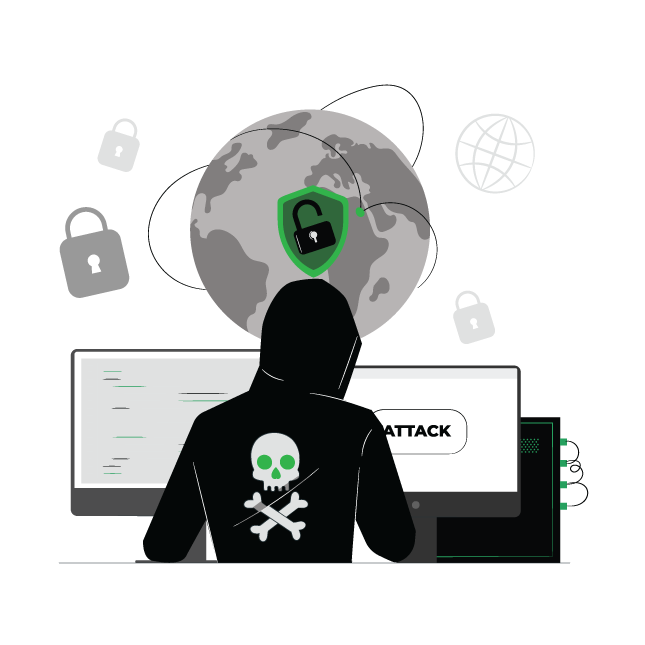
Cyber Threat Intelligence (CTI) is the process of gathering, analyzing, and disseminating information about current and potential cyber threats. It is used to proactively protect organizations and individuals from cyber-attacks. CTI enables organizations to understand the threat landscape and make informed decisions about how to defend their networks and systems.
The goal of CTI is to provide actionable intelligence that organizations can use to protect their networks and systems from cyber threats. This can include information about specific threat actors, their tactics, techniques, and procedures, as well as details about specific malware or vulnerabilities that should be patched. CTI can also include recommendations for specific actions that organizations can take to mitigate threats, such as implementing security controls or incident response plans.
CTI is an essential component of an overall cyber security strategy, as it provides organizations with the knowledge they need to defend against emerging threats. It can be used by a wide range of organizations, including government agencies, large corporations, and small businesses. CTI can be provided through internal teams, managed security services, or third-party vendors.
Cyber Threat Intelligence (CTI) is the process of gathering, analyzing, and disseminating information about current and potential cyber threats in order to proactively protect organizations and individuals from cyber-attacks. CTI enables organizations to understand the threat landscape and make informed decisions about how to defend their networks and systems.
There is no consensus on the exact definition of a cyber threat, and different organizations and analysts may have different interpretations depending on there “School of Thought”. A cyber threat can refer to the origin of the risk, meaning an individual or a group with malicious intent, also known as cyber adversaries, threat actors, or threat agents. These entities have the capability and intent to cause harm to an organization or individual through cyber means. A cyber threat can also refer to the risk event, meaning an action that is detrimental to the targeted organization. These events include malware, phishing scams, denial of service attacks, and more, and are often referred to as threat events, cyber attacks, or attack implementations.
The main activities involved in CTI include:
- Collection: Gathering information from a variety of sources, such as network traffic logs, malware samples, and social media posts. The source may be Open Source (OSINT), or closed source (commercial, cooperation, in-house).
- Analysis: Identifying patterns and trends in the collected data in order to understand the threat landscape, develop and track hypothesis, capitalized past information. The ultimate victory is to predict the next attacker move.
- Dissemination: Sharing actionable intelligence with relevant stakeholders, such as security teams, incident responders, and executives.
The process of CTI is supported by the use of a variety of tools, techniques and disciplines. Those are either performed by the cyber threat analyst itself, or by a dedicated specialized resources that is feeding the threat analysis. For example, Malware analysis examines malware samples to understand how they work, what they are doing and produce dedicated detection rules. Network traffic analysis skills are necessary to inspect network traffic logs to detect and investigate suspicious activity.
The type of data that CTI analyst may be exposed to are very diverses. As a cyber attack is expression of a strategic entity motivation and planification, that is implemented through technical means, the scope of the analysis may be multi-disciplinary, depending on the context of the organization, the CTI Team capability and the dissemination audience and expectation :
- Technical Intelligence: This type of data focuses on the technical aspects of cyber threats, such as malware samples, network traffic logs, and vulnerability information.
- Behavioral Intelligence: This type of data focuses on the behavior of threat actors, such as their tactics, techniques, and procedures (TTPs), as well as their motivations and intent.
- Threat Actor Intelligence: This type of data focuses on the identity and attributes of threat actors, such as their location, tools, and infrastructure.
- Geopolitical Intelligence: This type of data focuses on the geopolitical context of cyber threats, such as the political, economic and social factors that may drive a threat actor to conduct a cyber-attack.
- Industry Intelligence: This type of data focuses on the specific threats and vulnerabilities that affect a particular industry or sector.
- Vulnerability Intelligence: This type of data focuses on the vulnerabilities in software, hardware and services, and the patches and mitigations available.
- Cyber-Tactical Intelligence: This type of data focus on the current cyber-attacks and its characteristics, targets, motives and tactics. It is more useful for incident responders, to detect and respond to an ongoing attack.
Organizations can use a combination of these different types of data to gain a comprehensive understanding of the cyber threat landscape and make informed decisions about how to protect their networks and systems. But this also requiere to have strong analytical tools that can digest those multi-dimensional type of data to support analysts during their investigation. CTI frameworks are methodologies used to organize and structure the CTI process. The most popularly CTI Framework are generally:
- Diamond Model: A framework used to understand the various aspects of a cyber threat, including the threat actors, their motivations and capabilities, the malware and techniques used, and the victims and impacts. It is based on Porter’s Diamond Model.
- MITRE ATT&CK: A framework used to understand the tactics, techniques, and procedures (TTPs) used by threat actors in cyber attacks.
- Intrusion Kill Chain: A model developed by Lockheed Martin that describes the stages an attacker goes through in order to successfully compromise a target.
The audience of CTI includes security professionals and decision-makers within an organization, government agencies, and other organizations that are responsible for protecting networks and systems from cyber threats. Cyber Threat Intelligence is a fact-based and audience driven activity. Depending of the requester (a.k.a. customer) needs, the analyst may orient the collection, focus on one or more type of data type and produce their intelligence product with different format to fits the final audience needs.
Cyber Threat Intelligence is generally divided into three or four sub-types of activities, that all focus on different aspect of the attack lifecycle and context.
Strategic CTI is used to inform long-term decision-making and planning for an organization. It provides high-level information about the threat landscape and emerging trends, as well as the potential impact of those threats on the organization. It is often collected from a variety of sources such as open-source intelligence (OSINT), social media monitoring, press coverage and industry or geopolitical reports. Tools that can assist with this type of intelligence collection include: Press Platform, Industry and Policy specific documentationMedia Monitoring Platforms, Web Scraping tools, Data visualization tools.
Strategic CTI analysts need a strong understanding of the overall geopolitical landscape and emerging trends in the cyber security field. They also need to have good analytical skills and the ability to think strategically about the potential impact of threats on their organization. A background in business and administration , geopolitic and geography, or foreign policy is helpful.
Tactical CTI: This type of CTI is used to inform real-time to mid-term decisions and actions. It provides detailed information about ongoing attacks and the tools and tactics being used by attackers. This type of CTI is often used by incident responders and security operations teams to narrow down the adversary modus operandi. It is often collected from a variety of in-house sources such as network traffic logs, intrusion detection systems, and security incident and event management (SIEM) systems where the analyst as to deducte from technical trails the adversary’s behaviour. But also and mainly from outside source such as security industry blog article and whitepaper about threat activity. Tools that can assist with this type of intelligence collection include: Threat Intelligence Platforms(TIP), Media Monitoring Platforms, Web Scraping tools, Data visualization tools.
Tactical CTI analysts need a good understanding of the current threat landscape, the specific tactics, techniques, and procedures (TTPs) used by adversaries, and the modus operandi of different threat actors. A background in information security, computer science, or a related field is helpful for an tactical CTI analyst. Additionally, having knowledge in threat hunting, incident response, and network forensics is appreciated.
Operational CTI is used to inform short-term decisions and actions. It provides more specific information about current threats and vulnerabilities, as well as recommendations for how to mitigate them. This type of CTI is often used by incident responders and security operations teams. It is often collected from a variety of sources such as network traffic logs, intrusion detection systems, and security incident and event management (SIEM) systems. Tools that can assist with this type of intelligence collection include: Network Intrusion Detection Systems, Security Information and Event Management (SIEM) systems, Endpoint protection platforms (EPP).
Operational CTI analysts need a good understanding of the current threat landscape and the specific threats and vulnerabilities that are relevant to their organization. They also need to have good analytical skills and the ability to think critically about the potential impact of threats on their organization. A background in information security, computer science, or a related field is helpful, as well as past experience in Security Operating Center.
Technical CTI is focused on extracting technical indicators of cyber threats, such as malware samples, network traffic logs, and vulnerability information. Technical CTI is used by security teams to understand the technical details of a threat and to develop and implement detection rules. It is often collected from a variety of sources such as malware samples, network traffic logs, and vulnerability information. Tools that can assist with this type of intelligence collection include: Malware Analysis tools, Vulnerability scanners, Reverse Engineering tools.
Technical CTI analysts need an axcellent understanding of the technical aspects of cyber threats, such as malware and vulnerabilities. They also need to have good analytical skills and a strong understanding of programming and scripting languages. A background in computer science, software engineering, or a related field is helpful for a technical CTI analyst.
Threat Intel is a critical component of a comprehensive security strategy, as it can help organizations identify, prioritize, and respond to threats more effectively.
The key features of threat intelligence include:
- Proactive: Threat intelligence helps organizations anticipate and prepare for potential threats before they occur, rather than simply reacting to incidents after they happen.
- Specific: Threat intelligence is specific to an organization’s industry, assets, and potential adversaries, allowing organizations to focus on the threats that matter most to them.
- Current: Threat intelligence is always up-to-date, providing organizations with the most current information about the threat landscape.
The benefits of threat intelligence include:
- Improved security: Threat intelligence can help organizations identify and respond to threats more quickly and effectively, reducing the risk of a successful attack.
- Increased efficiency: Threat intelligence can help organizations prioritize their security efforts, allowing them to focus on the threats that pose the greatest risk.
- Better decision-making: Threat intelligence can provide organizations with the information they need to make more informed decisions about their security posture and response to incidents.
- Increased collaboration: Threat intelligence can be shared among organizations, allowing them to work together to better understand and protect against common threats.
Threat intelligence can be used to inform a variety of security-related activities, including incident response, vulnerability management, and penetration testing. It can also be used to support compliance efforts, such as meeting regulatory requirements for incident reporting and data protection.
Cyber threat intelligence best practices involve a combination of processes and procedures that organizations can use to effectively collect, analyze, and act on threat intelligence. it is important to note that cyber threat intelligence (CTI) is more than just having a security watch team in place.
CTI is a holistic approach to understanding and protecting against cyber threats that involves a combination of processes, procedures, and tools. Organizations that want to effectively protect themselves against cyber threats must develop a clear CTI strategy, build a dedicated CTI team, establish CTI processes, leverage automation, establish partnerships, continuously monitor and evaluate their program and incorporate CTI into the incident response plan.
By following these best practices, organizations can effectively collect, analyze, and act on CTI to better understand and protect against cyber threats. CTI is a key component in protecting an organization from cyber attacks and ensuring business continuity.
#1 - Developing a clear CTI strategy
A CTI strategy should outline the goals, objectives, and priorities of the organization’s CTI program, and provide guidance on how to effectively collect, analyze, and act on CTI. When developing a CTI strategy, organizations should consider the following:
- Goals and Objectives: Organizations should clearly define their goals and objectives for their CTI program. This may include identifying specific threats or types of attacks that the organization is particularly concerned about, or identifying specific assets or systems that the organization needs to protect.
- Resources: Organizations should identify the resources they will need to effectively implement their CTI program. This may include personnel, hardware, software, and budget.
- Intelligence Requirements: Organizations should identify their intelligence requirements and what type of information they need to collect, analyze, and act upon. This may include identifying specific types of threats, attack methods, or adversaries.
- Collection and Analysis: Organizations should develop a plan for collecting and analyzing CTI, including identifying sources of CTI, establishing procedures for analyzing and validating CTI, and developing processes for sharing CTI with relevant stakeholders.
- Integration: Organizations should integrate the CTI into the incident response plan, so in case of a cyber attack, the organization will have the knowledge and understanding of the threat and the capability to respond to the attack in a timely and effective way.
- Communication and Training: Organizations should develop a communication and training plan to ensure that relevant stakeholders are aware of the CTI program, understand its objectives, and are trained on how to use the information effectively.
Intelligence is a powerful tool for a sound cybersecurity strategy and governance. If the goals are not well defined, the output will be of low value for the organization’s security continuous improvment.
#2 - Establishing CTI processes
CTI processes are the set of procedures and guidelines that an organization follows to collect, analyze, and act on CTI. They are designed to ensure that the organization can effectively and efficiently gather, process, and disseminate relevant intelligence information.
When establishing CTI processes, organizations should consider the following:
- Collection: Organizations should establish processes for collecting CTI from a variety of sources, such as open-source information, vendor intelligence, and internal sources. This may include identifying specific sources of CTI, establishing procedures for collecting and validating CTI, and developing processes for sharing CTI with relevant stakeholders.
- Analysis: Organizations should establish processes for analyzing CTI, including identifying procedures for evaluating the relevance, reliability, and credibility of CTI, and determining how to use the CTI to support decision-making.
- Dissemination: Organizations should establish processes for disseminating CTI to relevant stakeholders, such as incident response teams, security teams, and other departments. This may include identifying specific stakeholders, determining the appropriate format for sharing CTI, and establishing procedures for sharing CTI in a timely manner.
By establishing CTI processes, organizations can effectively collect, analyze, and act on CTI to better understand and protect against cyber threats. This will help organizations to make informed decisions, prioritize their efforts and resources, and respond to cyber threats in a timely and effective way.
#3 - Leveraging automation
Leveraging automation in cyber threat intelligence (CTI) can help organizations to more efficiently and effectively gather, process, and disseminate CTI. There are several ways that automation can be used to enhance CTI processes, including:
- Data collection: To collect CTI from a variety of sources, such as open-source information, vendor intelligence, and internal sources. This can help organizations to more quickly and easily gather the information they need, and can also help to reduce the risk of human error.
- Data analysis: To analyze threat data , including identifying patterns and trends in the data, and evaluating the relevance, reliability, and credibility of CTI. This can help organizations to more quickly and easily understand the information they have collected, and can also help to reduce the risk of human error.
- Dissemination: To disseminate CTI to relevant stakeholders, such as incident response teams, security teams, and other departments. This can help organizations to more quickly and easily share the information they have collected and analyzed, and can also help to reduce the risk of human error.
- Integration: To integrate CTI into existing security systems and tools, such as firewalls, intrusion detection systems, and security information and event management systems. This can help organizations to more effectively leverage CTI to better understand and protect against cyber threats.
- Continuous monitoring and evaluation: To continuously monitor and evaluate CTI, so the organization can keep track of new threats and trends, and adjust their security measures accordingly.
Automation can also be used to automate the process of creating threat intelligence reports, this will save time for the analyst to focus on more important tasks. It’s important to note that automation should not be used to completely replace human analysts, but rather to support and enhance their work and reduce the repetitive non-added value tasks.In this context, CTI can leverage Data Engineer and Data Scientist to step up its capacity to produce actionable intelligence at scale.
#4 - Establishing partnerships & collaboration
Establishing partnerships and collaboration is generally counter-intuitive for decision-maker, as they may fear that sensitive information about the organization security posture is shared with outside parties, including government, regulatory body or competitors. But it is a fondamental aspect of cyber threat intelligence as it helps to gather more priviledged and accurate data and information about cyber attacks that is targeting the ecosystem, but not the organization, yet. The main benefits are:
- Sharing intelligence: Exchange CTI with other organizations, such as other companies in their industry, government agencies, and other relevant stakeholders to improve the knwoledge coverage. This can help organizations to more effectively gather and analyze CTI, as they can leverage the information and expertise of other organizations.
- Improving incident response: Improve cyber incidents response, as they can share information and coordinate their efforts with other organizations. This can help organizations to more quickly and effectively contain and mitigate cyber incidents.
- Enhancing threat detection: Enhance detection of cyber threats, as they can share information and expertise with other organizations, and leverage their collective resources to better understand and protect against cyber threats.
- Reducing costs: Partnerships and collaboration can help organizations to reduce the costs associated with gathering, processing, and disseminating CTI, as they can share resources and expertise with other organizations.
- Developing standards: Partnerships and collaboration can help organizations to develop and adhere to standards for CTI, this will ensure the quality of data being shared and the security of the sharing process.
- Building trust: Partnerships and collaboration can help organizations to build trust with other organizations, as they can share information and expertise, and work together to better understand and protect against cyber threats.
It is important to establish guidelines and protocols for information sharing, this will ensure that the information being shared is accurate, relevant, and timely. Also, the sharing process should be secure and the data should be protected. The MISP Project initiative, an European open-source project to join or create threat intelligence information sharing network, is an excellent example of such collaboration between NPO, Government, Private Sector and Law Enforcement entities.
#5 - Continuously monitoring and evaluating
Continuously monitoring and evaluating the cyber threat intelligence program is an important aspect of an effective strategy. The key point to monitor and improve are:
- CTI Processes: Regularly reviewing and updating CTI processes can help ensure that they are effective and efficient. This includes assessing the quality of the data being gathered, evaluating the effectiveness of the analysis and dissemination processes, and identifying and addressing any gaps in the CTI program.
- CTI Tools and Techniques: Continuously monitoring and evaluating the effectiveness of CTI tools and techniques can help identify and address any issues or limitations. This includes assessing the accuracy and reliability of the tools, evaluating the effectiveness of the techniques used to analyze and disseminate CTI, and identifying any areas for improvement.
- Performance Evaluation: Regularly evaluating the overall performance of the CTI program can help identify areas for improvement, and identify and address any issues. This includes assessing the effectiveness of the CTI program in achieving its goals and objectives, evaluating the effectiveness of the CTI program in protecting against cyber threats, and identifying and addressing any areas of weakness.
- Feedback and Improvement: Regularly receiving feedback from stakeholders and employees, and using that feedback to continuously improve the CTI process.
- Metrics: Establishing metrics to measure the performance of the CTI program, and using these metrics to evaluate the effectiveness of the program, identify areas for improvement, and demonstrate the value of the CTI program.
- Compliance: Ensuring that the CTI program is in compliance with relevant laws, regulations, and industry standards. As investigation may collect, store and exchange personnal identifier, it is mandatory to ensure the adherence to regulation such as GDPR and to conduct cyber audit to ensure the safe usage of those information.
Continuously monitoring and evaluating CTI is critical to ensuring that the program is effective and efficient. This includes regularly reviewing and updating CTI processes, assessing the effectiveness of CTI tools and techniques, and evaluating the overall performance of the CTI program. By continuously monitoring and evaluating CTI it improve the overall performance over time.
#6 - Incorporating the CTI into the incident response plan
Incorporating cyber threat intelligence (CTI) into the incident response plan is an important aspect of an effective incident response strategy. CTI can provide valuable information about potential threats and vulnerabilities, as well as insights into the tactics, techniques, and procedures (TTPs) used by cyber adversaries. This information can help organizations better prepare for and respond to cyber incidents.
Here are some key elements of incorporating CTI into the incident response plan:
- Threat Identification: Incorporating CTI can help organizations identify potential threats and vulnerabilities, and prioritize incident response efforts based on the most likely or severe threats.
- TTP Analysis: CTI can provide insights into the TTPs used by cyber adversaries, which can help organizations better understand the tactics and techniques that may be used in an attack.
- Indicator of Compromise (IOC) Identification: CTI can provide information about specific indicators of compromise (IOCs), such as IP addresses, file hashes, and domain names, that can be used to detect and respond to cyber incidents.
- Playbooks: Developing incident response playbooks that incorporate CTI can help organizations quickly and effectively respond to cyber incidents.
- Training: Incorporating CTI into incident response training can help ensure that incident response teams are familiar with the latest threats and TTPs, and can better prepare for and respond to cyber incidents.
- Integration: Integrating CTI into incident response tools and platforms can help automate the incident response process and improve the efficiency and effectiveness of incident response efforts.
- Collaboration: Collaborating with other organizations and sharing CTI can help organizations better prepare for and respond to cyber incidents.
In summary, incorporating CTI into the incident response plan is critical to effective incident response. CTI can provide valuable information about potential threats and vulnerabilities, as well as insights into the TTPs used by cyber adversaries. This information can help organizations better prepare for and respond to cyber incidents, and can help incident response teams more effectively and efficiently respond to cyber incidents.
Cyber Threat Intelligence (CTI) is a critical component of an organization’s overall security strategy. It provides organizations with the ability to understand, anticipate, and respond to cyber threats by providing actionable intelligence about the current and evolving threat landscape. CTI is relevant for a wide range of audiences and issues, including security operations centers, attack detection, digital forensics and incident response, red team and attack simulation, compliance and the evolving threat landscape, and vulnerability management prioritization. By implementing a CTI strategy, organizations can gain a more comprehensive understanding of the threats they face and prioritize their efforts accordingly.
Security Operation Center and Cyber Attacks Detection
CTI can play a critical role in incident detection and response in a SOC. By providing actionable intelligence on the latest threats, vulnerabilities, and tactics used by cyber adversaries, CTI can help the SOC detect and respond to incidents more quickly and effectively. Specific use cases include the detection of APTs, zero-day vulnerabilities and improving incident response activities. Furthermore, CTI can help the SOC identify and track specific cyber adversaries and threat groups and aid in incident attribution and identification of potential countermeasures.
One key use case for CTI in a SOC is in the detection of advanced persistent threats (APTs). APTs are highly targeted attacks that are designed to gain long-term access to an organization’s networks and data. CTI can provide information on the tactics, techniques, and procedures (TTPs) used by APT actors, which can help the SOC detect and respond to APT-related incidents. For example, CTI can provide information on specific indicators of compromise (IOCs), such as IP addresses, domain names, and file hashes, that can be used to detect APT-related activity on the network.
Another use case for CTI in a SOC is in the detection of zero-day vulnerabilities. Zero-day vulnerabilities are software vulnerabilities that are unknown to the vendor or the public. CTI can provide information on new or previously unknown vulnerabilities, which can help the SOC detect and respond to incidents related to zero-day vulnerabilities. For example, CTI can provide information on specific software versions that are affected by a particular vulnerability, which can help the SOC identify and patch affected systems.
Digital Forensic and Incident Response
Coupling CTI with the incident response plan can greatly enhance the effectiveness of DFIR efforts. By leveraging the knowledge and information provided by CTI, incident responders can make more informed decisions, prioritize their response efforts, and more effectively identify and mitigate the impact of a cyber attack. It is important to note that CTI is a continuous process, and incident responders should regularly review and update their CTI data and incident response plans to stay current with the evolving threat landscape.
One use case for CTI in DFIR is in the identification and tracking of threat actors. CTI can provide information on known threat actors and their tactics, techniques, and procedures (TTPs). This information can help incident responders determine if a specific threat actor is responsible for an attack, and if so, what specific TTPs they are likely to use. This can aid in the identification of indicators of compromise (IOCs) and the development of appropriate response and mitigation strategies.
Another use case for CTI in DFIR is in the identification of malware and other malicious software. CTI can provide information on known malware families and their associated TTPs. This information can help incident responders identify malware that may be present on a compromised system and determine the likely intent of the malware. This can aid in the development of appropriate response and mitigation strategies.
CTI can also be used to identify and track malicious infrastructure, such as command and control (C2) servers, used by threat actors. This information can help incident responders identify and disrupt the infrastructure used by an attacker and can aid in the identification of other compromised systems.
Red Team and Attack Simulation
Incorporating CTI into Red Team and Attack Simulation exercises can greatly enhance their realism and effectiveness. By leveraging the knowledge and information provided by CTI, Red Team members can develop more sophisticated and realistic simulated attacks that better mimic the tactics used by real-world adversaries.
CTI can provide information on known vulnerabilities and exploit techniques used by threat actors. This information can help the Red Team identify potential attack vectors that may be missed by traditional vulnerability scanning or penetration testing. It can also help in identifying the most likely attack vectors that can be used by the adversaries.
Another use case for CTI in Red Team exercises is in the development of realistic attack scenarios. CTI can provide information on the TTPs used by specific threat actors, such as the tools and techniques used by advanced persistent threats (APTs). This information can be used to create more realistic and sophisticated attack scenarios that better mimic the tactics used by real-world adversaries.
It can also be used to inform the development of simulated phishing campaigns and social engineering attacks. CTI can provide information on the types of phishing campaigns and social engineering tactics used by real-world threat actors, which can be used to create more realistic and effective simulated attacks.
Compliance and Evolving Threat Landscape
Enhancing the collaboration between CTI and compliance can help organizations to meet regulatory requirements, identify and mitigate vulnerabilities, and stay current with the evolving threat landscape.
CTI can provide information on the specific regulatory requirements for an organization’s industry or sector, such as healthcare or finance. This information can help the organization to understand the specific requirements they must meet, and to identify any gaps in their current security measures.It can also provide information on the latest threats, vulnerabilities and attack techniques that are being used by cybercriminals. This information can be used to identify potential vulnerabilities in the organization’s systems and networks, and to develop strategies for mitigating these risks.
CTI can also be used to identify the latest trends in the threat landscape. CTI can provide information on emerging trends, such as the latest ransomware attacks or phishing scams. This information can be used to understand the evolving threat landscape, and to develop strategies for addressing these new threats.
Vulnerability Management Prioritization
Cyber Threat Intelligence can be used to support a risk-based vulnerability management program by providing organizations with the ability to prioritize vulnerabilities based on the likelihood and impact of an attack. This approach to vulnerability management, known as threat intelligence and vulnerability management, allows organizations to focus their resources on the vulnerabilities that pose the greatest risk to their organization.
One key benefit of incorporating CTI into vulnerability management is the ability to prioritize vulnerabilities based on the activities and tactics of known or suspected threat actors. By understanding the methods and techniques used by these actors, organizations can identify which vulnerabilities are most likely to be exploited and prioritize their remediation accordingly. This approach, known as attack-based vulnerability prioritization, is more effective than traditional methods of prioritizing vulnerabilities such as CVSS scores alone.
Another benefit of CTI in vulnerability management is the ability to prioritize vulnerabilities based on the criticality of the assets they impact. By understanding the importance of different assets to the organization, security teams can determine which vulnerabilities require immediate attention and which can be addressed at a later time. This approach is known as vulnerability remediation prioritization.
Incorporating CTI into vulnerability management also allows organizations to stay informed about the evolving threat landscape and adapt their remediation efforts accordingly. This can be especially important for organizations in highly regulated industries, as compliance requirements may dictate which vulnerabilities must be addressed first.
Incorporating CTI into a vulnerability management program can help organizations prioritize vulnerabilities based on the likelihood and impact of an attack, stay informed about the evolving threat landscape, and adapt their remediation efforts accordingly. By using CTI to support risk-based vulnerability management, organizations can improve the efficiency and effectiveness of their vulnerability remediation efforts and better protect their systems and data from cyber threats.





